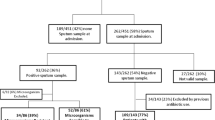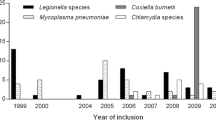Abstract
Background
The aim of this secondary analysis was to evaluate current microbiological approaches, microbiology, and antibiotic therapy in patients with community-acquired pneumonia (CAP) and acute exacerbation of chronic obstructive pulmonary disease (AECOPD) in clinical practice and to compare them with current international guidelines.
Methods
A total of 362 patients with suspected CAP were enrolled in 14 European centers in a prospective multicenter study.
Results
A total of 279 inpatients (CAP, n = 222; AECOPD, n = 57) were evaluated. A total of 83 (37 %) CAP patients and 25 (44 %) AECOPD patients did not undergo any microbiological tests. In patients with CAP/AECOPD, blood culture was performed in 109 (49 %)/16 (28.1 %), urinary antigen tests for Legionella pneumophila in 67 (30 %)/9 (16 %), and sputum investigation in 55 (25 %)/17 (30 %), respectively. The most frequent pathogens in CAP were Streptococcus pneumoniae, Mycoplasma pneumoniae, Chlamydia pneumoniae, L. pneumophila, Staphylococcus aureus, and Enterobacter cloacae; in AECOPD they were Escherichia coli, Haemophilus haemolyticus, Haemophilus influenzae, and Moraxella catarrhalis. All CAP patients (mean = 11.1 days) and 35 (61.4 %) of AECOPD patients (mean = 8.9 days) received antibiotics. CAP patients were given mostly aminopenicillin with β-lactamase inhibitors and AECOPD patients were given mostly cephalosporins.
Conclusions
Pathogens isolated in CAP and AECOPD and the antibiotic therapy used are in good accordance with the guidelines. Blood culture, recommended for all CAP patients, was performed in only 50 % of the cases and antibiotic therapy lasted longer than the suggested 5–7 days. Therefore, international guidelines regarding performance of blood culture and duration of antibiotic therapy should be adopted more often. This duration was independent of the number of isolated pathogens and number of symptoms on admission. Therefore, the question arises as to whether microbiological data are necessary only for patients who are resistant to initial therapy.
Similar content being viewed by others
Abbreviations
- AECOPD:
-
Acute exacerbation of chronic obstructive pulmonary disease
- ATS:
-
American thoracic society
- BTS:
-
British thoracic society
- CAP:
-
Community-acquired pneumonia
- COPD:
-
Chronic obstructive pulmonary disease
- CT:
-
Computed tomography
- ERS:
-
European respiratory society
- IDSA:
-
Infectious disease society of America
- LRTI:
-
Lower respiratory tract infection
- PCR:
-
Polymerase chain reaction
References
Woodhead M, Blasi F, Ewig S, Garau J, Huchon G, Ieven M et al (2011) Joint task force of the European respiratory society and European society for clinical microbiology and infectious diseases. Guidelines for the management of adult lower respiratory tract infections—full version. Clin Microbiol Infect 17(Suppl 6):1–59
Höffken G, Lorenz J, Kern W, Welte T, Bauer T, Dalhoff K et al (2009) Epidemiology, diagnosis, antimicrobial therapy and management of community-acquired pneumonia and lower respiratory tract infections in adults. Guidelines of the Paul-Ehrlich-Society for Chemotherapy, the German Respiratory Society, the German Society for Infectiology and the competence network CAPNETZ Germany. Pneumologie 63:e1–e68
Global strategy for the diagnosis, management, and prevention of chronic obstuctive pulmonary disease. www.goldcopd.org. Accessed Feb 2013
Lim WS, Baudouin SV, George RC, Hill AT, Jamieson C, Le Jeune I et al (2009) Pneumonia guidelines committee of the BTS standards of care committee. BTS guidelines for the management of community acquired pneumonia in adults. Thorax 64(Suppl 3):1–55
National Institute for Health and Care Excellence, National Clinical Guideline Centre, Chronic Obstructive Pulmonary Disease (2010) Management of chronic obstructive pulmonary disease in adults in primary and secondary care (CG101). http://guidance.nice.org.uk/CG101
Mandell LA, Wunderink RG, Anzueto A, Bartlett JG, Campbell GD, Dean NC et al (2007) Infectious diseases society of America; American thoracic society (2007) Infectious diseases society of America/American thoracic society consensus guidelines on the management of community-acquired pneumonia in adults. Clin Infect Dis 44(Suppl 2):S27–S72
Celli BR, MacNee W, ATS/ERS Task Force (2004) Standards for the diagnosis and treatment of patients with COPD: a summary of the ATS/ERS position paper. Eur Respir J. 23:932–946
Reissig A, Copetti R, Mathis G, Mempel C, Schuler A, Zechner P et al (2012) Lung ultrasound in the diagnosis and follow-up of community-acquired pneumonia. A prospective multicentre diagnostic accuracy study. Chest 142:965–972
National Committee for Clinical Laboratory Standards (2004) Performance standards for antimicrobial susceptibility testing, 14th informational supplement. Approved standard M100-S14. Wayne, PA: National Committee for Clinical Laboratory Standards
Herrero FS, Olivas JB (2012) Microbiology and risk factors for community-acquired pneumonia. Semin Respir Crit Care Med 33:220–231
Welte T, Köhnlein T (2009) Global and local epidemiology of community-acquired pneumonia: the experience of the CAPNETZ network. Semin Respir Crit Care Med 30:127–135
Pletz MW, Rohde G, Schütte H, Bals R, von Baum H, Welte T (2011) Epidemiology and aetiology of community-acquired Pneumonia (CAP). Dtsch Med Wochenschr 136:775–780
Echols RM, Tillotson GS, Song JX, Tosiello RL (2008) Clinical trial design for mild-to-moderate community-acquired pneumonia—an industry perspective. Clin Infect Dis 47(Suppl 3):S166–S175
Aliberti S, Blasi F, Zanaboni AM, Peyrani P, Tarsia P, Gaito S (2010) Duration of antibiotic therapy in hospitalised patients with community-acquired pneumonia. Eur Respir J 36:128–134
Li JZ, Winston LG, Moore DH et al (2007) Efficacy of short-course antibiotic regimens for community-acquired pneumonia: a metaanalysis. Am J Med 120:783–790
Acknowledgments
The authors are indebted to the following: Claus Kroegel, Rotraud Neumann, Sylvia Fischer, Monika Möbius, Dr. Heike Hoyer, and Christine Dietrich (Friedrich-Schiller-University Jena, Germany); Maurizio Vergendo and Grazia Portale (Emergency Department Tolmezzo, Italy); Andreas Schuler and Gerhard Fenk (Helfenstein Clinic Geislingen, Germany); Peter Zechner, Fritz Flückiger, Herbert Wurzer, Susanne Rienmüller, and Gerald Geyer (Hospital Graz West, Austria); Roberto Cosentini and Andrea Gramegna (Emergency Department and Respiratory Department, University of Milan, IRCCS Fondazione Cà Granda Ospedale Maggiore Policlinico, Milan, Italy); Gebhard Mathis and Thomas Amann (Medical practice Rankweil, Austria); Alexander Heinzmann, Wolfgang Blank, and Bernd Braun (Hospital Reutligen, Germany); Antonin Polach, Peter Schmidt, and Ernst Deu (Hospital Stolzalpe, Austria); Jörg Kämmer and Bernd Kissig (St. Hedwig Clinic Berlin, Germany); Hubert Bertolini and Markus Ammann (Medical practice Dornbirn, Austria); Martin Mauch (Hospital Sigmaringen, Germany); Harald Simader and Rudolg Kaiser (Diakonissen-Hospital Schladming, Austria); and Cornelia Schirpke and Kathrin Ludwig (Pulmonary Clinic Lostau gGmbH, Germany).
Conflict of interest
The authors have no conflicts of interest or financial ties to disclose.
Author information
Authors and Affiliations
Corresponding author
Rights and permissions
About this article
Cite this article
Reissig, A., Mempel, C., Schumacher, U. et al. Microbiological Diagnosis and Antibiotic Therapy in Patients with Community-Acquired Pneumonia and Acute COPD Exacerbation in Daily Clinical Practice: Comparison to Current Guidelines. Lung 191, 239–246 (2013). https://doi.org/10.1007/s00408-013-9460-x
Received:
Accepted:
Published:
Issue Date:
DOI: https://doi.org/10.1007/s00408-013-9460-x




